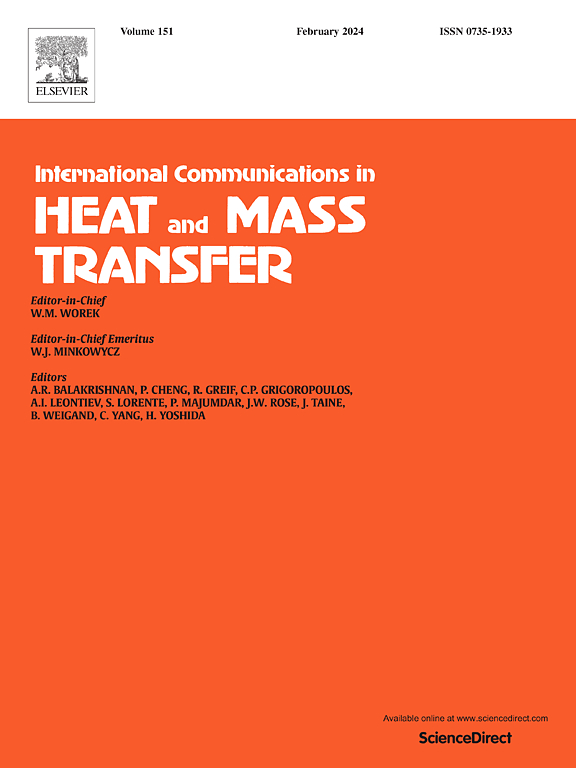Experimental study the effect of differences in heat transfer in different freezing directions on the distribution characteristic of trapped bubbles in ice slices
IF 6.4
2区 工程技术
Q1 MECHANICS
International Communications in Heat and Mass Transfer
Pub Date : 2025-07-01
DOI:10.1016/j.icheatmasstransfer.2025.109295
引用次数: 0
Abstract
Icing is common in industry and nature and always has a negative effect. To cope with ice damage, it is necessary to understand the icing mechanisms. The presence of trapped air bubbles in ice is a common phenomenon during icing, and these bubbles affect the thermal, mechanical and other physical properties of ice. To understand the distribution characteristics of trapped air bubbles in ice, a water film freezing experimental setup is built. To clarify the effect of heat transfer on trapped air bubbles, five experiments of water film freezing under different freezing directions are carried out. The results showed that both egg-shaped and needle-shaped bubbles showed a tendency to increase and then decrease as the freezing direction changed from vertically upward to vertically downward. When the freezing direction angle is 135°, the widths of the two types of bubbles reach their maximum values, which are 182.5 μm and 134.3 μm, respectively. The study helps to understand and predict the growth and distribution of trapped air bubbles in ice, which in turn can provide a reference for the optimization of de-icing and ice-breaking techniques.
实验研究了不同冻结方向的换热差异对冰片中困泡分布特性的影响
结冰在工业和自然界中很常见,而且总是有负面影响。为了应对冰害,有必要了解冰害机理。在结冰过程中,冰中存在被困的气泡是一种常见现象,这些气泡影响冰的热、机械和其他物理性质。为了了解冰中被困气泡的分布特性,建立了水膜冻结实验装置。为了阐明换热对捕获气泡的影响,在不同的冻结方向下进行了5次水膜冻结实验。结果表明:随着冻结方向由垂直向上变为垂直向下,卵状和针状气泡均呈现先增大后减小的趋势;当冻结方向角为135°时,两种气泡的宽度达到最大值,分别为182.5 μm和134.3 μm。该研究有助于了解和预测冰中被困气泡的生长和分布,从而为优化除冰和破冰技术提供参考。
本文章由计算机程序翻译,如有差异,请以英文原文为准。
求助全文
约1分钟内获得全文
求助全文
来源期刊
CiteScore
11.00
自引率
10.00%
发文量
648
审稿时长
32 days
期刊介绍:
International Communications in Heat and Mass Transfer serves as a world forum for the rapid dissemination of new ideas, new measurement techniques, preliminary findings of ongoing investigations, discussions, and criticisms in the field of heat and mass transfer. Two types of manuscript will be considered for publication: communications (short reports of new work or discussions of work which has already been published) and summaries (abstracts of reports, theses or manuscripts which are too long for publication in full). Together with its companion publication, International Journal of Heat and Mass Transfer, with which it shares the same Board of Editors, this journal is read by research workers and engineers throughout the world.

 求助内容:
求助内容: 应助结果提醒方式:
应助结果提醒方式:


